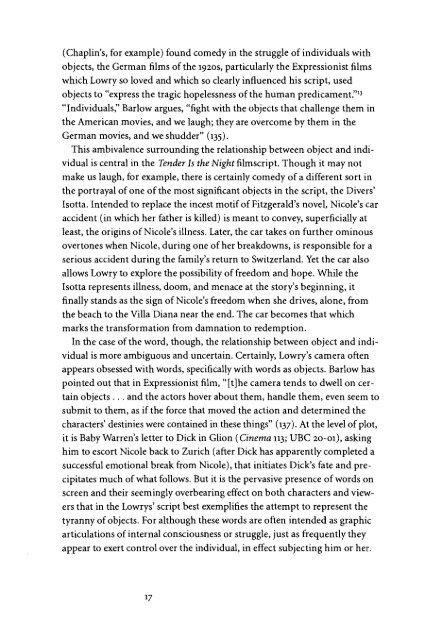A Quarterly of Criticism and Review i^^^^^^^^fcEjfc $15
A Quarterly of Criticism and Review i^^^^^^^^fcEjfc $15
A Quarterly of Criticism and Review i^^^^^^^^fcEjfc $15
Create successful ePaper yourself
Turn your PDF publications into a flip-book with our unique Google optimized e-Paper software.
(Chaplin's, for example) found comedy in the struggle <strong>of</strong> individuals withobjects, the German films <strong>of</strong> the 1920s, particularly the Expressionist filmswhich Lowry so loved <strong>and</strong> which so clearly influenced his script, usedobjects to "express the tragic hopelessness <strong>of</strong> the human predicament." 13"Individuals," Barlow argues, "fight with the objects that challenge them inthe American movies, <strong>and</strong> we laugh; they are overcome by them in theGerman movies, <strong>and</strong> we shudder" (135).This ambivalence surrounding the relationship between object <strong>and</strong> individualis central in the Tender Is the Night filmscript. Though it may notmake us laugh, for example, there is certainly comedy <strong>of</strong> a different sort inthe portrayal <strong>of</strong> one <strong>of</strong> the most significant objects in the script, the Divers'Isotta. Intended to replace the incest motif <strong>of</strong> Fitzgerald's novel, Nicole's caraccident (in which her father is killed) is meant to convey, superficially atleast, the origins <strong>of</strong> Nicole's illness. Later, the car takes on further ominousovertones when Nicole, during one <strong>of</strong> her breakdowns, is responsible for aserious accident during the family's return to Switzerl<strong>and</strong>. Yet the car alsoallows Lowry to explore the possibility <strong>of</strong> freedom <strong>and</strong> hope. While theIsotta represents illness, doom, <strong>and</strong> menace at the story's beginning, itfinally st<strong>and</strong>s as the sign <strong>of</strong> Nicole's freedom when she drives, alone, fromthe beach to the Villa Diana near the end. The car becomes that whichmarks the transformation from damnation to redemption.In the case <strong>of</strong> the word, though, the relationship between object <strong>and</strong> individualis more ambiguous <strong>and</strong> uncertain. Certainly, Lowry's camera <strong>of</strong>tenappears obsessed with words, specifically with words as objects. Barlow haspointed out that in Expressionist film, "[t]he camera tends to dwell on certainobjects ... <strong>and</strong> the actors hover about them, h<strong>and</strong>le them, even seem tosubmit to them, as if the force that moved the action <strong>and</strong> determined thecharacters' destinies were contained in these things" (137). At the level <strong>of</strong> plot,it is Baby Warren's letter to Dick in Glion {Cinema113; UBC 20-01), askinghim to escort Nicole back to Zurich (after Dick has apparently completed asuccessful emotional break from Nicole), that initiates Dick's fate <strong>and</strong> precipitatesmuch <strong>of</strong> what follows. But it is the pervasive presence <strong>of</strong> words onscreen <strong>and</strong> their seemingly overbearing effect on both characters <strong>and</strong> viewersthat in the Lowrys' script best exemplifies the attempt to represent thetyranny <strong>of</strong> objects. For although these words are <strong>of</strong>ten intended as graphicarticulations <strong>of</strong> internal consciousness or struggle, just as frequently theyappear to exert control over the individual, in effect subjecting him or her.
















